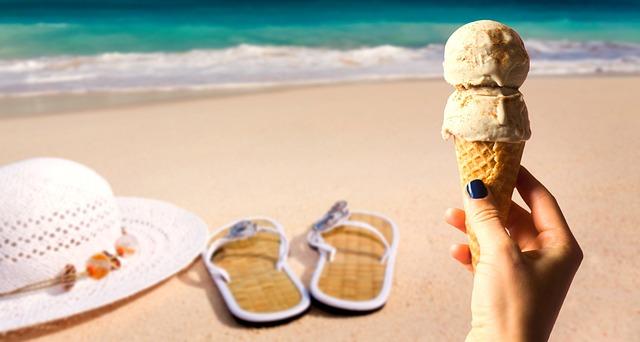Ice Bath Challenge: Transforming Your Body with Cold Therapy

Are you ready to take your wellness journey to the next level? Look no further than the exhilarating Ice Bath Challenge! In this article, we dive deep into the fascinating realm of cold therapy and uncover the transformative benefits that chilling in icy waters can have on your body and mind. From enhancing muscle recovery to boosting your immune system, we’ll reveal the science behind this age-old practice and share practical tips to help you embark on your own cold therapy adventure. So, grab a towel and get ready to discover the incredible health benefits that await you in the world of ice baths!
Contents
- 1. Unveiling the Science Behind Cold Therapy: How Ice Baths Can Revolutionize Your Workout Recovery
- 2. Beyond the Chill: Exploring the Physical Benefits of Ice Baths for Muscle Repair and Growth
- 3. Dive Into the Mental Benefits: Enhancing Focus, Mental Resilience, and Stress Reduction with Cold Therapy
- 4. The Perfect Prescription: Finding the Optimal Ice Bath Routine to Maximize Results
- 5. From Beginner to Pro: Gradually Incorporating Cold Therapy Into Your Fitness Regimen
- 6. Addressing Common Concerns: Debunking Myths and Overcoming Challenges of Ice Baths
- 7. Cold Immersion Techniques: Exploring Alternatives to Traditional Ice Baths
- 8. Best Practices for Safety and Comfort: Preparing and Acclimating to Ice Baths
- 9. Post-Ice Bath Recovery Strategies: Maximizing the Effects and Minimizing Discomfort
- 10. Unlocking the Potential: Long-Term Transformations from Consistent Cold Therapy Practices
1. Unveiling the Science Behind Cold Therapy: How Ice Baths Can Revolutionize Your Workout Recovery
Cold therapy, specifically ice baths, has gained popularity in the world of workout recovery. But what is the science behind it, and how can it revolutionize your fitness regimen? Let’s delve into the world of cold therapy and explore how ice baths can transform your body.
The Benefits of Ice Baths
Ice baths, also known as cold water immersion, involve submerging your body in ice-cold water for a short period. This practice may seem daunting, but the benefits it offers are worth the initial shock. Here are some ways ice baths can enhance your workout recovery:
- Reduced inflammation: Cold temperatures cause blood vessels to constrict, which helps in reducing inflammation and swelling in muscles. This means faster recovery time for workout-induced muscle damage.
- Enhanced muscle repair: Cold therapy stimulates blood circulation, promoting the delivery of oxygen and nutrients to damaged muscles. This accelerates the muscle repair process and aids in better muscle growth.
- Improved performance: Ice baths have been shown to enhance the body’s ability to cope with intense exercise. By reducing muscle soreness and fatigue, they can boost your overall performance during future workouts.
How to Optimize Your Ice Bath Experience
If you’re ready to take on the ice bath challenge, here are some tips to make the most of your cold therapy experience:
- Gradual temperature decrease: Start by adding a few ice cubes to cool water and gradually decrease the temperature over time. This helps your body adapt and reduces the initial shock.
- Stay hydrated: Proper hydration is essential before, during, and after an ice bath. Make sure to drink plenty of fluids to prevent dehydration.
- Monitor the duration: Begin with shorter durations, around 5-10 minutes, and gradually increase the time as you become more comfortable with the cold exposure.
Remember, before incorporating ice baths into your routine, it’s important to consult with a healthcare professional, especially if you have any underlying medical conditions. Now, embrace the chill and unlock the power of ice baths to revolutionize your workout recovery!
2. Beyond the Chill: Exploring the Physical Benefits of Ice Baths for Muscle Repair and Growth
Ice baths, once reserved for elite athletes, are gaining popularity among fitness enthusiasts looking to take their recovery to the next level. Beyond the chill, these icy immersions have been shown to provide numerous physical benefits for muscle repair and growth.
One of the key advantages of ice baths is their ability to reduce inflammation in the body. When you immerse yourself in cold water, the blood vessels constrict and shunt blood away from the muscles, decreasing swelling and flushing out metabolic waste. This process can alleviate muscle soreness and aid in the repair of micro-tears that occur during intense workouts.
In addition to reducing inflammation, cold therapy also helps enhance circulation. As the body tries to warm up, it increases blood flow, delivering oxygen and nutrients to the muscles at an accelerated rate. This improved circulation can enhance muscle recovery and promote growth. Furthermore, ice baths can also boost metabolism, aiding in weight loss and fat burning.
To fully experience the benefits of ice baths, it is recommended to follow a proper protocol. Start with a 10-15 minute soak in water that is around 50-60 degrees Fahrenheit (10-15 degrees Celsius). Gradually increase the amount of time spent in the bath, aiming for 20 minutes. Remember, never stay in an ice bath for longer than 30 minutes, as prolonged exposure to cold temperatures can lead to negative effects such as hypothermia.
If you’re up for the challenge, incorporating ice baths into your post-workout routine can provide a range of physical benefits that go beyond just feeling refreshed. So, embrace the cold and discover the transformative power of cold therapy on your journey towards a stronger, more resilient body.
3. Dive Into the Mental Benefits: Enhancing Focus, Mental Resilience, and Stress Reduction with Cold Therapy
One of the most incredible aspects of cold therapy is its ability to enhance focus, mental resilience, and reduce stress. By subjecting your body to extreme temperatures, you’re challenging your mind and reaping the mental benefits that come along with it. The Ice Bath Challenge is not just about transforming your body, but also transforming your mind.
Enhancing Focus:
- Regular cold therapy has been shown to improve cognitive function and enhance mental clarity.
- Exposure to cold temperatures stimulates the release of norepinephrine, a neurotransmitter responsible for improving focus and attention.
- By incorporating cold therapy into your routine, you can experience increased productivity and sharpened mental acuity.
Mental Resilience:
- Cold therapy acts as a powerful training tool for building mental resilience.
- By exposing yourself to uncomfortable environments, you learn to push past your comfort zone and overcome mental barriers.
- Over time, your mind becomes stronger and more resilient, allowing you to overcome challenges with ease.
Stress Reduction:
- Immersing yourself in cold water triggers the body’s relaxation response, reducing stress levels and promoting a sense of calmness.
- The release of endorphins during cold therapy helps to alleviate anxiety and improve your overall mood.
- Regular cold therapy sessions can help you manage stress more effectively, leading to improved mental well-being.
By embracing the Ice Bath Challenge and incorporating cold therapy into your routine, you’ll not only transform your body but also unlock the incredible mental benefits that come along with it. Get ready to enhance your focus, build mental resilience, and reduce stress with the power of cold therapy.
4. The Perfect Prescription: Finding the Optimal Ice Bath Routine to Maximize Results
Ice baths have long been a secret weapon for athletes looking to enhance their recovery and improve overall performance. But what is the optimal ice bath routine to maximize results? In this post, we will delve into the perfect prescription for transforming your body with cold therapy.
-
Timing is everything: It’s important to time your ice bath correctly to ensure maximum benefits. Experts recommend taking an ice bath within 30 minutes to 2 hours after a workout. This window allows your body to take full advantage of the cold therapy and speed up the recovery process.
-
Temperature matters: The ideal temperature for an ice bath is between 50 to 59 degrees Fahrenheit (10 to 15 degrees Celsius). This range provides an optimal balance between effectiveness and tolerability. Be sure to monitor the temperature closely using a thermometer to avoid extreme cold exposure.
-
Duration for optimal results: The duration of an ice bath can vary depending on individual preferences and comfort levels. However, most athletes find that submerging their bodies in ice-cold water for 10 to 15 minutes yields the best results. It’s essential to listen to your body and gradually increase the duration over time to avoid shock or discomfort.
- Enhance the experience: To make your ice bath routine more enjoyable, consider incorporating relaxation techniques such as deep breathing, meditation, or listening to calming music. These practices can not only help distract your mind from the cold but also promote a sense of overall well-being.
Remember, everyone’s body is unique, and what works for one person may not work for another. Experiment with different ice bath routines, temperatures, and durations to find the optimal combination that maximizes your results. Stay consistent, be patient, and embrace the power of cold therapy to transform your body and enhance your athletic performance.
5. From Beginner to Pro: Gradually Incorporating Cold Therapy Into Your Fitness Regimen
Ice baths, or cold therapy, have gained popularity among athletes and fitness enthusiasts for their potential benefits in speeding up recovery and enhancing performance. If you’re new to cold therapy and unsure about how to incorporate it into your fitness routine, fear not! We’ve got you covered with some tips to help you gradually incorporate cold therapy into your regimen and start reaping the rewards.
-
Start small: Begin by incorporating cold therapy into your post-workout routine, rather than diving straight into ice baths. This can be as simple as applying an ice pack to target areas of soreness or discomfort after a workout. Gradually increase the duration and intensity of cold exposure as your body becomes accustomed to it.
-
Gradually transition to ice baths: Once you’re comfortable with applying local cold therapy, you can progress to taking ice baths. Fill a tub or container with cold water and add ice cubes until the temperature is between 50 and 59 degrees Fahrenheit (10-15 degrees Celsius). Ease yourself into the cold water and gradually increase the time spent in the bath, starting with just a few minutes and working your way up to around 10-15 minutes.
-
Combine cold therapy with active recovery: To optimize the benefits of cold therapy, consider incorporating it into your active recovery routine. Engage in light exercises, such as stretching or low-impact cardio, immediately after your ice bath. This can help promote blood circulation and enhance the recovery process.
- Listen to your body: Pay attention to how your body responds to cold therapy. If you experience any excessive discomfort or adverse effects, it’s important to modify or discontinue the practice. Everyone’s tolerance and response to cold therapy may vary, so it’s essential to listen to your body’s signals.
Remember, gradual incorporation and consistency are key when it comes to reaping the benefits of cold therapy. By gradually introducing ice baths into your fitness regimen and paying attention to your body’s signals, you can unlock the potential benefits of cold therapy and take your fitness journey to the next level. So, why not challenge yourself and embrace the transformative power of cold therapy today?
6. Addressing Common Concerns: Debunking Myths and Overcoming Challenges of Ice Baths
Embarking on an ice bath challenge may seem daunting at first, with various concerns and doubts running through your mind. However, it’s essential to separate fact from fiction and equip yourself with the knowledge needed to overcome any challenges that may arise. Let’s debunk some common myths surrounding ice baths and find ways to overcome potential hurdles:
Myth 1: Ice baths are too painful to endure
It’s true that immersing your body in freezing cold water is not the most comfortable experience. However, the discomfort usually subsides after a few minutes as your body adapts to the cold temperature. To make the process more manageable, start with shorter durations and gradually increase the time spent in the ice bath. This allows your body to acclimatize without overwhelming your senses.
Myth 2: Ice baths can lead to hypothermia
While it’s important to approach ice baths with caution, the risk of hypothermia is minimal if proper precautions are taken. Limit your ice bath sessions to a maximum of 10-15 minutes and always monitor your body’s response. Additionally, ensure the water temperature is between 50-59°F (10-15°C) to prevent extreme cold exposure. By adhering to these guidelines, you can safely reap the benefits of cold therapy without endangering your health.
Myth 3: Ice baths don’t offer any significant benefits
Contrary to popular belief, ice baths have numerous benefits for both physical and mental well-being. Cold therapy through ice baths can improve muscle recovery, reduce inflammation, enhance cardiovascular health, and even boost your immune system. By incorporating ice baths into your routine, you can optimize your body’s recovery process and unlock new levels of performance.
7. Cold Immersion Techniques: Exploring Alternatives to Traditional Ice Baths
Cold immersion techniques offer a unique and alternative approach to traditional ice baths for those seeking the transformative benefits of cold therapy. While ice baths have long been used to aid in recovery after intense physical activity, recent research has shown that there are multiple ways to achieve the same results without subjecting yourself to the discomfort of sitting in a tub of ice water.
One alternative method gaining popularity is cold showers. By exposing your body to a short burst of cold water at the end of your regular shower, you can reap many of the same benefits as an ice bath. Cold showers can help reduce inflammation, improve circulation, and increase your body’s production of endorphins, resulting in improved mood and overall well-being. Plus, they’re much more convenient and less time-consuming than a full ice bath.
Another technique worth exploring is cryotherapy, a treatment that involves exposing your body to extremely cold temperatures, typically through the use of specialized cryo chambers. This method has been praised for its ability to reduce pain and inflammation, enhance recovery, and improve athletic performance. Cryotherapy sessions usually last for just a few minutes, making it a great option for those with busy schedules.
In addition to cold showers and cryotherapy, there are other cold immersion techniques to consider, such as cold water swimming, cold water therapy, and contrast therapy (alternating between hot and cold treatments). Each technique offers its own unique set of benefits and can be tailored to individual needs and preferences. So, if you’re looking to take your recovery and performance to the next level, why not give these alternatives to traditional ice baths a try? Your body will thank you!
8. Best Practices for Safety and Comfort: Preparing and Acclimating to Ice Baths
When it comes to enhancing your overall well-being and achieving your fitness goals, ice baths may seem like a daunting challenge. However, incorporating cold therapy into your routine can have incredible benefits for both your body and mind. In this post, we’ll delve into the best practices for safety and comfort when preparing and acclimating to ice baths, helping you maximize the transformative power of cold therapy.
1. Start Slowly
- Briefly expose your body to colder temperatures to gradually acclimate your system.
- Begin with cold showers or dipping your feet in icy water for a short duration.
- Over time, increase the exposure and duration to build tolerance.
2. Be Mindful of Water Temperature
- Take caution not to use freezing water as it can be detrimental to your health.
- Opt for water around 50-59 degrees Fahrenheit (10-15 degrees Celsius) to reap the benefits without causing harm.
- Always monitor the temperature to ensure it remains within the safe range.
3. Practice Proper Breathing Techniques
- Focus on slow, deep breaths to help relax your body and minimize discomfort.
- Breathe in through your nose and out through your mouth, allowing your body to adjust to the cold.
- Stay relaxed and practice mindfulness during your ice bath session, staying present in the moment.
| Benefits of Ice Baths | Duration |
|---|---|
| Reduced inflammation | 5-10 minutes |
| Improved circulation | 2-5 minutes |
| Faster recovery | 15-20 minutes |
Remember, cold therapy may not be suitable for everyone, so it’s essential to consult with a healthcare professional before incorporating ice baths into your routine. By following these best practices and gradually acclimating to ice baths, you can embark on a transformative journey towards optimal wellness and discover the incredible benefits of cold therapy.
9. Post-Ice Bath Recovery Strategies: Maximizing the Effects and Minimizing Discomfort
After completing your ice bath, it’s important to focus on post-recovery strategies to maximize the effects of the cold therapy and minimize any discomfort. These strategies will help your body recover faster and allow you to reap the full benefits of the ice bath challenge.
-
Active Recovery Exercises: Engaging in light exercises after an ice bath can help promote blood flow and aid in the recovery process. Consider activities such as gentle stretching, yoga, or light cardio to get your muscles moving and prevent stiffness.
-
Contrast Therapy: Alternating between hot and cold treatments can enhance the effects of an ice bath. After your ice bath, take a warm shower or soak in a hot bath for a few minutes, followed by a quick cold shower or ice pack application. This contrast therapy helps with circulation and reduces inflammation.
-
Rehydration and Nutrition: It’s crucial to replenish fluids lost during the ice bath and provide your body with the necessary nutrients for recovery. Drink plenty of water to stay hydrated and consider consuming a balanced meal or snack that includes protein, healthy fats, and carbohydrates.
- Rest and Sleep: Giving your body the time it needs to rest and recover is essential after any physical activity, including an ice bath. Aim for a good night’s sleep and incorporate rest days into your routine to allow your muscles and joints to repair and rebuild.
Remember, ice bath therapy can be a powerful tool for transforming your body, but it’s important to listen to your body’s signals and adjust the intensity and duration of cold therapy accordingly.
10. Unlocking the Potential: Long-Term Transformations from Consistent Cold Therapy Practices
<p>Cold therapy, specifically through ice baths, has gained immense popularity in recent years due to its numerous health benefits. Beyond just a brief refreshing sensation, consistent cold therapy practices can lead to remarkable long-term transformations for your body. Here are some ways in which <a href="https://alphamalefts.com/2023/01/26/chris-bumstead-ice-bath-insights-into-the-bumstead-cold-therapy/" title="Chris Bumstead Ice Bath: Insights into the Bumstead Cold Therapy">regular ice bath sessions</a> can unlock your body's potential:</p>
<ul>
<li><strong>Enhanced muscle recovery:</strong> Cold therapy has been found to significantly reduce muscle inflammation and soreness by constricting blood vessels. This allows for a quicker removal of waste products and a faster delivery of nutrients to your muscles, supporting their repair and growth.</li>
<li><strong>Increased endurance and performance:</strong> Regular ice baths can improve your body's ability to withstand intense physical activity. The cold temperature stimulates the production of heat-shock proteins, which aid in the protection and repair of cells and tissues, ultimately enhancing your endurance and performance levels.</li>
<li><strong>Accelerated fat burning:</strong> Cold therapy activates your brown adipose tissue, a type of fat that burns calories to generate heat. By regularly exposing your body to cold temperatures, you can increase your metabolic rate, resulting in a more efficient fat-burning process.</li>
<li><strong>Improved immune function:</strong> Cold therapy has been shown to stimulate the production of white blood cells and boost the activity of your immune system. By regularly subjecting your body to cold temperatures, you can strengthen your body's defense mechanisms and reduce the risk of falling ill.</li>
</ul>
<p>Incorporating ice baths into your fitness routine may seem challenging at first, but the potential benefits are undeniable. It is important to gradually build up your tolerance and seek professional guidance to ensure safe and effective practice. Start by gradually decreasing the water temperature and duration of your ice baths, allowing your body to adapt over time. Transform your body by embracing the power of cold therapy and witness the incredible long-term effects it can have on your overall well-being.</p>In conclusion, the Ice Bath Challenge is not just a trendy viral sensation, but a powerful tool for transforming your body through the remarkable benefits of cold therapy. By subjecting your body to the chill-inducing water, you can optimize your physical performance, accelerate muscle recovery, and even boost your immune system. Don’t let the initial shock deter you – embrace the challenge and witness the positive changes it can bring to your overall well-being. So, why not take the plunge and embark on this icy adventure? Grab your towel, summon your courage, and dive headfirst into the extraordinary world of the Ice Bath Challenge. Your body will thank you for it!













